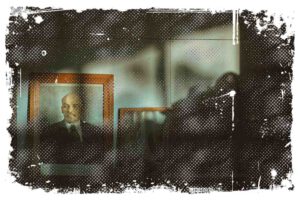Let me say that the history of a city and its industry not only shape the life stories of the people living there but also reflect the city’s growth and development. Seventy years ago, a prominent figure in the glassworks community, Dr. Eng. W. Heinrich, founded a glass factory in Tarnów. This factory has since played a significant role in the city’s history and the lives of its inhabitants.

I think it’s worth mentioning that the founder, W. Heinrich, hailed from Cieszyn Silesia in the Czech Republic and Krosno. He brought with him not only his experience but also his collaborators. The profession of a metallurgist was passed down from father to son, leading to the emergence of specific families associated with the profession and the glass factory. Some of the most important families were the Wokanow brothers, Burger, and Sztandler.

The glass factory, located at Św. Trójcy 251, was officially registered on April 26, 1934. If you want to know how the factory grew, I can tell you that it developed rapidly. By 1939, it already employed 180 people. The factory produced crystal products, glasses, and vases, which were cut in another plant owned by Heinrich in Cieszyn. Just before the war, it began producing heat-resistant dishes as well.
Why Tarnów was Chosen for the Glass Factory
I am convinced that the choice of Tarnów for the investment site was not accidental. At that time, Galicia was becoming an area of large state investments under the so-called COP, which included the construction of the Zakłady Azotowe in Mościce. The region also had a large human potential, good infrastructure (railway connections), and other factors that favored the establishment of busineses like the Tarnów glass factory.
↳ PRO TIP: Do you like traveling? Then before you buy any ticket or book an attraction, check if it's available in this worldwide Viator Database. You may save a lot of money and time. No need to thank me :)
War’s Impact on Tarnów’s Glass Factory
The outbreak of war initially didn’t bring about major changes in the factory’s production range. However, the structure of the employed workforce did change. Most of the employees of Jewish origin were deported to Auschwitz, and men left their jobs and residences amidst the chaos of war. Consequently, mainly women were hired at the plant, including those who had been resettled from Wielkopolska.
It was only after the Wehrmacht launched the Eastern Front in 1941 that the glass factory was forced to shift its production towards military purposes, primarily focusing on pharmacy bottles.
Post-War Reconstruction and Changes in Management
On January 26, 1945, just 8 days after the Red Army entered the city, Tarnów’s president, Edward Sit, took over the management of the factory. Initially, management focused on supervising the abandoned property and attempting reconstruction under the watchful eye of Ludwik Milbauer. In October of that year, the glass factory came under the control of the Glass Industry Association Północ in Piotrków Trybunalski, and within a few months, its management was transferred to an association in Sosnowiec.

You may also be interested in reading about post-war development in Poland: Challenges of Rebuilding Poland’s Infrastructure After World War II
Production resumed in 1946 under the direction of Adam Filipowicz, initially under the name State Glassworks d. Dr. Eng. W. Heinrich, and later as State Glassworks. The factory primarily produced glass packaging due to the staff shortage experienced before 1939, which led to the name change to Huta Szkła Opakowaniowego „Tarnów” (or Zakłady Szkła Opakowaniowego „Tarnów”).
Returning to Pre-War Production
I believe it’s important to note that it wasn’t until 1957 that the factory resumed production of items similar to those made before the war. Glassworkers manually produced glasses, mugs, stemware, and more.

This change was reflected in the name, with the factory becoming known as Zakłady Szkła Gospodarczy „Tarnów,” and later HSG „Tarnów”.However, in the 1990s, the name „Blowex” was added during a wave of anglicization, which I can tell you doesn’t seem like a particularly fortunate linguistic choice.
Expansion and New Production Plant in Piaskówka
Under Bogdan Kalicki’s management in 1966, the glass factory saw its potential for growth exhausted at Św. Trójcy. Consequently, the construction of a new production plant in Piaskówka began. Launched in 1966, the new plant initially employed 436 people. By December 1969, training for almost 250 future employees had started.
Diverse Product Range and Technology
The Piaskówka plant mainly produced table glass with an extensive variety of shapes, colors, and patterns. Full production capacity was reached in 1972, with 1033 employees working at the plant. In 1978, automatic production of wine glasses began, with the capability to produce nearly 57,000 glasses per day.
The factory’s modern technology crew gained valuable experience during internships in Belgium, France, and even Japan. From 1971, the glass factory became a part of the Association of Economic and Technical Glassworks „Vitropol” in Sosnowiec. After 1981, due to changes in the economic system, the plant was taken over by the Ministry of Chemical and Light Industry.
Challenges and Continued Growth
On November 5, 1982, a fire broke out in the technical warehouse, posing a serious threat to the entire plant. This led to a brief production stoppage and a loss of spare parts for production machines. Due to martial law, importing parts from abroad became difficult, significantly hindering the production cycle. The warehouse and a new administration building were put into use in 1984.
Despite the challenging start to the 1990s, the high quality of products, the unique color of the glass, and satisfied international customers helped the factory continue its production. Profits rose from USD 5.7 million in 1996 to nearly USD 9 million in 2000. The factory saw its highest employment in 1980, with 1,338 employees and 5,662 tons of glass produced. In 1999, 300 fewer people were employed, but production was 1,000 tons higher. Since July 13, 2001, the factory’s ownership structure changed, with 80 percent of its shares being sold.
Closure of Tarnów Household Glassworks in 2012

Dariusz Gawroński, General Director of Krośnieńskie Huty Szkła, admits that the decision to halt production in Tarnów was influenced by the challenging market situation. The number of orders dropped dramatically, and continuing to maintain the Tarnów plant would mean spending a significant amount of money. Gawroński expressed his personal regret about the situation.
Glass Factories in Tarnów Today

Although the historic Tarnów Household Glassworks has closed its doors, the city of Tarnów is still home to numerous smaller glass factories. These smaller factories primarily focus on producing handmade and crafted glass, which allows them to thrive in the market. If you’re interested in purchasing glassware from these local artisans, you’ll find that their products offer a unique touch and exceptional quality.

I can tell you that there are several benefits to using and purchasing glassware made by small glass factories like those found in Tarnów. First and foremost, handmeade and crafted glass items have an unmistakable charm and character, with each piece being one-of-a-kind. Additionally, these smaller factories often prioritize using sustainable practices and materials, which is an added bonus for eco-conscious consumers. Finally, by supporting these local artisans, you are contributing to the local economy and helping to preserve the rich glassmaking tradition of Tarnów.

References:
- https://www.it.tarnow.pl/atrakcje/tarnow/ciekawostki/taka-jest-historia/huta-szkla-w-tarnowie/




